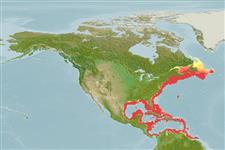分类 / Names
俗名 | 同种异名 | Catalog of Fishes(属, 种) | ITIS | CoL | WoRMS | Cloffa
Teleostei >
Anguilliformes (Eels and morays)
鰻目 (Eels and morays) >
Anguillidae (Freshwater eels)
鰻鱺科(Freshwater eels) (Freshwater eels)
Etymology: Anguilla: Latin, anguilla, .-ae = eel (Ref. 45335); rostrata: Anguilla, Latin for eel, and rostrata, Latin for beaked or curved (presumably a characteristic of which only Lesueur was aware) (Ref. 79012).
More on author: Lesueur.
Environment: milieu / climate zone / depth range / distribution range
生态学
海洋; 淡水; 半咸淡水 居于水底的; 降海洄游 (Ref. 26938); 深度上下限 0 - 464 m (Ref. 57178). 亞熱帶的; 4°C - 25°C (Ref. 12468); 66°N - 5°N, 98°W - 21°W
Northwest to western Central Atlantic: Greenland south along the Atlantic coast of Canada and the USA to Panama, and throughout much of the West Indies south to Trinidad.
美國: 格陵蘭向南延伸加拿大與美國的大西洋海岸到巴拿馬, 而且在西印度群島的多處各處南至千里達。
Length at first maturity / 大小 / 重量 / 年龄
Maturity: Lm 68.5, range 37 - 100 cm
Max length : 152 cm TL 雄鱼/尚未辨别雌雄; (Ref. 26938); 122.0 cm TL (female); common length : 50.0 cm TL 雄鱼/尚未辨别雌雄; (Ref. 3242); 最大体重: 7.3 kg (Ref. 4699); 最大年龄: 43 年 (Ref. 40922)
背棘 (总数) : 0; 臀棘: 0. Head rather long; eyes small and placed well forward on head. Lips thick. Caudal vertebrae without transverse processes. Premaxillae not developed as distinct elements in adults. Frontal bones paired, not grown together. Pectoral girdle with 7 to 9 (up to 11 in the young) radial elements. Adults usually white or light-colored below and brownish to blue-black above, but coloration is variable; young with some yellow on the edges of the dorsal and anal fins (Ref. 30499). Caudal fin rounded, joined to dorsal and anal fins. Gill opening on side in front of lower half of well-developed pectoral fin; lower jaw longer than upper; 103-111 vertebrae (Ref. 26938).
头部相当长的; 眼小的而且位于头部正前方。 唇厚的。 没有横断突起的尾部的脊椎骨。 前颌骨不发展成明显的要素当成鱼时。 额骨成对的, 不一起生长。 肩带 7 到 9(向上到 11 在幼鱼里面)个动脉要素。 成鱼通常白色或者颜色较淡在与之下背面褐色到深蓝色的, 但是颜色是可变的; 幼鱼有一些黄色的背鳍与臀鳍的边缘。 (参考文献 30499) 尾鳍圆形的, 连到了背鳍与臀鳍。 在发展良好的胸鳍之下半部之前的在侧边上的鳃裂; 下颌比上颌长; 103-111个脊椎骨.(参考文献 26938)
Occurs in streams, rivers, muddy or silt-bottomed lakes (Ref. 5951); usually in permanent streams with continuous flow (Ref. 86798). Hides during the day in undercut banks and in deep pools near logs and boulders (Ref. 86798). Feeds on larvae of Ephemeroptera, Odonata, Plecoptera, Coleoptera, Trichoptera, and Lepidoptera, as well as gastropods, oligochaetes, amphipods, isopods, mysids, and fish from the families Percidae, Cyprinidae, Ictaluridae, Catostomidae and Anguillidae (Ref. 9593). Migrates in autumn to the Sargasso Sea to spawn (Ref. 3242). Sexual maturity occurs approximately in less than10 years and up to 40 years in freshwater (Ref. 57533). Larvae (transparent leptocephali shaped somewhat like a willow leaf) hatch and develop at sea to metamorphose into elvers in nearshore waters and estuaries (Ref. 57533). Adults are caught with eel pots and trot lines. Elvers and glass eels are caught with fine mesh fyke nets and dipnets. Catadromous species. (Ref. 26938). Maximum depth reported taken from Ref. 57178.
通常生活在永久的溪流有连续的水流。 在圆木与大圆石附近的堤岸下与深水池中隐藏在白天期间。 吃蜉蝣的幼生,蜻蛉, ?翅目,鞘翅目,毛翅目与鳞翅目, 以及腹足动物,蠕虫,片脚类动物,等足目动物,糠虾, 而且捕食鲈科, Cyprinidae ,鮰科,亚口鱼科与 Anguillidae.(参考文献 9593) 秋天时回游到藻海 产卵.(参考文献 3242) 成鱼被用鳗鱼壶罐与快步线捕获。 鳗苗与玻璃鳗鱼被用细网目的待袋网与手抄网捕获。 一个降海洄游的种。 (参考文献 26938). 最大的深度报告取自參考文獻 57178.
Undertakes migration in autumn to the Sargasso Sea where spawning is said to take place. Coloration changes with sexual maturation. Dorsal surface of the pectorals becomes dark, lateral line becomes prominent, eye diameter increases and visual pigments change, body takes on a silvery bronze coloration. Females are usually larger than males and migrate much farther upstream (Ref. 57533). Adults die after spawning (Ref. 30499).
Spawn at sea but growth occurs in estuaries or freshwater (Ref. 7135). Spawning grounds believed to be between 20° and 30°N and 60°and 75°W (Ref. 40916, 40917).美國: 格陵蘭向南延伸加拿大與美國的大西洋海岸到巴拿馬, 而且在西印度群島的多處各處南至千里達。
Page, L.M. and B.M. Burr, 1991. A field guide to freshwater fishes of North America north of Mexico. Houghton Mifflin Company, Boston. 432 p. (Ref. 5723)
世界自然保护联盟红皮书 (Ref. 130435)
濒危 (EN) (A2bd); Date assessed: 08 November 2020
人类利用
渔业: 商业性; 养殖: 商业性; 游钓鱼种: 是的; 水族馆: 公众的水族馆
工具
特别资料
下载 XML
网络资源
Estimates based on models
Preferred temperature (Ref.
123201): 0.5 - 24.3, mean 6.3 °C (based on 323 cells).
Phylogenetic diversity index (Ref.
82804): PD
50 = 0.5000 [Uniqueness, from 0.5 = low to 2.0 = high].
Bayesian length-weight: a=0.00087 (0.00070 - 0.00108), b=3.18 (3.13 - 3.23), in cm total length, based on LWR estimates for this species (Ref.
93245).
营养阶层 (Ref.
69278): 3.8 ±0.2 se; based on diet studies.
回复力 (Ref.
120179): 低的, 最小族群倍增时间4.5 - 14 年 (tm=3-6; tmax=43; Fec=5,000,000).
Fishing Vulnerability (Ref.
59153): High to very high vulnerability (72 of 100).
Climate Vulnerability (Ref.
125649): High vulnerability (60 of 100).
Nutrients (Ref.
124155): Calcium = 32.2 [19.9, 67.1] mg/100g; Iron = 0.734 [0.430, 1.146] mg/100g; Protein = 19.6 [17.8, 21.5] %; Omega3 = 0.367 [0.197, 0.697] g/100g; Selenium = 56 [29, 105] μg/100g; VitaminA = 8.64 [1.82, 42.50] μg/100g; Zinc = 0.64 [0.46, 0.92] mg/100g (wet weight); based on
nutrient studies.
